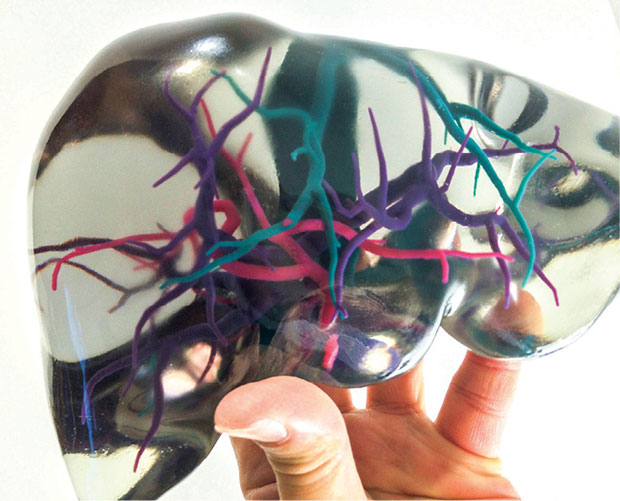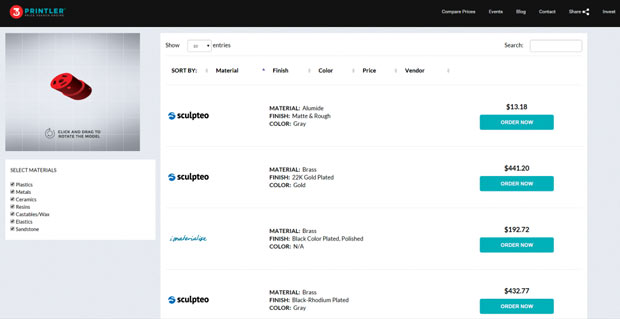The Price of 3D Printing

Stratasys Direct Manufacturing offers many 3D printing production technologies. Pictured here are some of the company’s Fused Deposition Modeling systems. Image courtesy of Stratasys.
Latest News
April 1, 2016
 3Dprintler lets users compare printing costs from several different service bureaus. Image courtesy of 3Dprintler.
3Dprintler lets users compare printing costs from several different service bureaus. Image courtesy of 3Dprintler.After several decades, 3D printing is now a familiar tool within the engineering community for prototypes and even end-use parts. It has gone from novelty to necessity, so now engineers must figure out how to work within tighter budgets and project deadlines. In response, companies and organizations providing 3D printing services are developing online quoting tools and support to help meet 3D printing costing challenges.
Getting Started
Most price quoting tools — which are available from manufacturing companies and third parties — have a similar workflow. Users can upload their CAD file, select the manufacturing method and material, and get an estimate. But more companies are offering additional tools and services to ensure design engineers are getting prototypes that best fit their needs.
With customer-facing pricing tools, “one of the biggest benefits is being able to discover and browse your options,” says Tomek Sysak, communications manager at 3Dprintler. Sysak explains that the pricing tools are a good way for beginners to explore some of the base offerings from multiple 3D printing service bureaus and manufacturers. For more experienced users, say those who already own desktop systems, “they [sometimes] don’t realize the material options are much wider than the ones that are available at home,” he says.
Beyond the individual, companies can implement price-quoting software to streamline customer orders and offer the complete design-to-print workflow. One platform in use by industrial 3D printer manufacturers and service bureaus is RP Platform (formerly 3D Printeo). The company describes its software as a platform that simplifies and automates additive manufacturing processes from CAD file preparation to production, including quotations and customer orders. “There are no two businesses with same approach to cost estimation and pricing, so our platform is highly flexible,” says Keyvan Karimi, RP Platform founder and CEO. “We have more than 20 attributes customers can use to create their own pricing logic and pricing formulas without needing any coding skills.”
Keeping Costs Down
Depending on an engineer’s needs, sometimes it’s not possible to reduce the cost of a part. However, there are a couple of considerations that could help make 3D printing cheaper. “Some of the general factors that affect the cost of 3D printing are the technology you’re choosing to print on, the material [you’re] trying to print on, [as well as] print size and the volume of the part,” says Tim Thellin, director of Software and Productivity Tools at Stratasys Direct Manufacturing.
Manually preparing models to make them ready for 3D printing is another huge time sink that can add costs if you rely on a service provider to do it. That’s why RP Platform includes a “shrink wrap” feature as part of its offering of additive manufacturing process automation tools, says Karimi. “It can take a CAD model and shrink wrap it to allow us to process complex models at incredible speed,” he says.
 When using stereolithography as a production method, it’s important to account for material removal to avoid additional cost or time. Image courtesy of Proto Labs.
When using stereolithography as a production method, it’s important to account for material removal to avoid additional cost or time. Image courtesy of Proto Labs.Adding support structures can also drive up cost, Thellin notes, because they take more time and labor to create within a print. “If users can design their geometries in such a way to reduce the amount of support structures, that can also have an impact on price,” he says. Additionally, a lot of technologies do rely on cubic volume to produce prints, so minimizing material use in designs can result in cheaper prints.
Build time should also be a consideration, because it is a large factor in print cost, says Eric Utley, applications specialist at Proto Labs. “[Build time] is driven by the part volume, build height and resolution,” he explains. “It is most cost effective to build all the parts on an order in the same material and resolution so that they can all be built at the same time. Typically adding a part to a[n initial] build is very cheap compared to ordering it later on a second build.”
Sometimes to address this issue, Thellin says they’ll print a larger part as several smaller pieces for cost effectiveness and efficiency.
Sysak adds that costs can be accrued in the processing and finishing of a prototype, as most general materials do have a fixed printing price. “Afterward, if you want a certain texture or smoothing, usually someone has to go and do that for you. A lot of the time if you choose a simple material and the natural finish for that material, then you’ll get the best price,” he explains.
Designing for 3D Printing
3D printing also has different design considerations than some traditional manufacturing methods. By accounting for these before any production, engineers can ensure a smoother manufacturing workflow with fewer iterations and reworking.
“The most common mistake I see is not allowing for clearing of excess resin or powder for stereolithography (SLA) or powder-sintered parts,” says Utley. “Designers can add voids to reduce material, but there needs to be access holes to clear the excess material. SLA resin is similar in viscosity to olive oil and the sintered powders are similar in consistency to flour. When adding voids, designers should ask themselves if they could reasonably remove the excess material from their parts. We recommend adding access holes to the opposite ends of the voids to allow the excess material to be drained.”
Another consideration should be wall thickness. Utley says he often sees designs with walls too thin to form. He recommends doing a sweeping cross section view through a part and look for unintentional thin sections.
To help with some of these design challenges, some companies will also provide quick-use design tools to ensure that models can be 3D printed. Shapeways, a community-oriented 3D printing service provider, has a basic Web-based modeler for design work and Creator apps to expand accessibility.
“We created [the] 3D Tools to allow us to fix things very quickly on Shapeways, so that [designers] don’t have to jump off the platform, go back into 3D modeling software, tinker with their model there and re-upload it,” says Mansee Muzumdar, PR associate at Shapeways. These options are also good exploratory tools for designers that may not yet know the specifics of their design — such as preferred material or printing process, she adds.
Working With Service Providers
Even though online quoting can be useful to start the production process, there can still be a learning curve for engineers not familiar with 3D printing materials or technologies. This is where service providers or more consumer-oriented companies can help smooth out the process.
“There are a lot of online capabilities for doing instant quotes, [but working with service providers] is a value when you’re not quite sure what you want. If we better understand what your application is, what you’re going to do with the part and the quantity, we’ll be able to help drive the customer to the right technology and material,” Thellin says.
 Stratasys Direct Manufacturing offers many 3D printing production technologies. Pictured here are some of the company’s Fused Deposition Modeling systems. Image courtesy of Stratasys.
Stratasys Direct Manufacturing offers many 3D printing production technologies. Pictured here are some of the company’s Fused Deposition Modeling systems. Image courtesy of Stratasys.Service providers can also reduce product development time, design risk and production snafus. “By utilizing a service provider, product developers can focus on their designs and not worry about the upkeep of 3D printing equipment,” Utley says.
Working with service providers can also lessen the learning curve associated with 3D printing. “A lot of people choose 3D printing because they have a design that you really can’t do any other way,” says Muzumdar. “However, 3D modeling and design [can have] a pretty steep learning curve. By connecting people to designers who use Shapeways, we’re able to help them get their ideas off the ground.”
Today’s pricing tools and service companies are helping engineers gain more access to a decades-old technology. In doing so, firms can leverage 3D printing to create better models and parts to ensure their designs will withstand real-world conditions.
More Info
Subscribe to our FREE magazine, FREE email newsletters or both!
Latest News
About the Author
Jess Lulka is a former associate editor for Digital Engineering. Contact her via [email protected].
Follow DE





